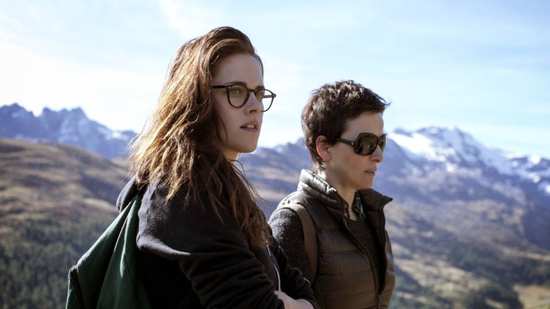Review for Clouds of Sils Maria
I had the pleasure of chatting with French writer-director Olivier Assayas after the screening of his film, Summer Hours, at the Toronto International Film Festival in 2008. Across the street from where we were standing, Toronto film fans were becoming increasingly frenzied as a red carpet premiere got underway. Assayas watched the scene intensely with, if I had to guess, a mix of bemusement, cynicism and genuine curiosity.
Assayas has always had a complex relationship with the film industry. As a critic at Cahiers Du Cinéma in the early 80s, when the Hollywood blockbuster was reshaping how films were made and shown globally, Assayas wrote extensively on what a new French cinema should look like. As he moved into filmmaking, his critique on the state of French film continued. Irma Vep for instance, gently satirised a French film industry that was desperately looking for a clear path forward while unable to step out from the shadow of its past.
While his contemporaries, like Bresson and Jeunet, became highly successful embracing the slick production values of Hollywood films to tell their stories of social marginalisation in Mitterand’s France, Assayas went a very different way, turning to a more natural aesthetic to tell stories informed by modern painting and fictional narrative.
In his latest film, Clouds of Sils Maria, Assayas looks at the effects of the new global film industry on three women at different stages in their film careers. Juliette Binoche plays Maria Enders, a middle aged actress who grudgingly agrees to play the part of an older woman in a play she helped make famous when she played a younger character 20 years earlier. Kristen Stewart plays Valentine, Maria’s long-time personal assistant and confidant - a role which won Stewart the César award for Best Supporting Actress. And Chloe Grace Moretz plays Jo-Ann Ellis, the American ingenue cast to play the younger woman opposite Maria.
Maria is on her way to a tribute for a Bergman-like director, Wilhelm Melchior, who helped jump start her career with the play and film, Maloja Snake, about a successful older woman who falls in love with her protégé only to be rejected and driven to suicide. En route, Maria discovers Melchior has died. Partly out of commitments to sponsors and media, the tribute goes ahead. At the ceremony, a respected director, a stand-in for Assayas himself, persuades Maria to appear in his remounting of Maloja Snake, the play, but this time as the older Helen. Maria feels she still embodies the younger character, Sigrid, and at first resist the idea of playing Helen until convinced by Valentine - Originally, Assayas had intended the play to be Fassbinder’s The Bitter Tears of Petra von Kant, but eventually settled on his own streamlined version.
At the invite of Wilhelm’s widow, Rosa, Maria and Valentine stay in a cottage in Sils Maria in the Swiss Alps where they rehearse the play. As Maria and Valentine flesh out the female characters, lines are blurred between reality and fiction - often their conversations merge with those of the characters in the play, raising questions about the nature of their relationship. It’s in these scenes that Assayas is able to mine the film’s themes of time, ageing, female identity, female conflict, celebrity and how they’re all affected by the film industry.
Assayas doesn’t just go negative on mainstream film and pop-culture. Like the reporter in Irma Vep who speaks up for Jakie Chan and Van Damme films, he has Kristen Stewart defend her generation’s love for superhero films, gossip blogs, and Hollywood ’it girl’, Jo-Ann Ellis - praising her with the second most reflexive line in film, “she’s not completely antiseptic like the rest of Hollywood… brave enough to be herself”. The first, in case you’re wondering, is uttered when perusing scripts for Maria, “There are werewolves involved, for whatever reason”.
Maria and Valentine have several of these conversations while hiking through the Alps hoping to glimpse a cloud phenomenon, and the film’s central metaphor, the Maloja Snake - whereby clouds roll in quickly over an Italian lake and form one giant snake-shaped cloud. Like celebrity, ideas, people - it disappears just as quickly. It’s during the sighting of the Maloja Snake that Valentine mysteriously vanishes.
Chloe Grace Moretz’s Jo-Ann Ellis spends most of the film removed from Valentine and Maria. We are introduced to her via YouTube clips showing her various Hollywood scandals. Her Lohan-Cyrus-Stewart mashup is the antithesis of Maria’s dame of French cinema who is befuddled by Ellis’s TMZ type stardom and suspicious about working with her. When the three finally meet, Jo-Ann, like the scheming Sigrid in the play, wins Maria over with what feels like genuine praise, forcing Maria to put aside any reservations she had about appearing opposite her on stage. In one final mirroring of play-film-reality, Maria tries to pass on some sage advice to Ellis who dismisses her outright saying “we’ve already seen that, it’s time to move on.”
Like Bergman, Assayas feels the acting suffers if he gets too involved. The actors are encouraged to try new things and they trust him to keep what works and to discard what doesn’t. For the most part, letting Binoche, Stewart and Moretz run free without going completely off script, works marvellously. Occasionally though, Assayas is perhaps too generous in the edit as we see the actors working. Binoche, especially, is caught dipping into her actor’s bag of tricks, falling back one too many times on her sudden, gregarious laugh to punctuate a scene. In a film about film though, it still somehow works.

Your Opinions and Comments
Be the first to post a comment!